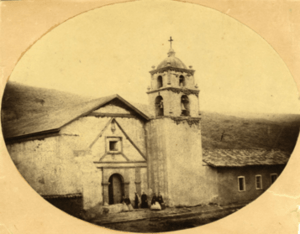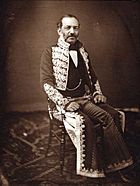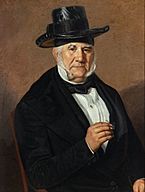Battle of San Buenaventura facts for kids

The Battle of San Buenaventura was a fight that happened on March 27 and 28, 1838. It was fought between two groups who both wanted to be the governor of California. At that time, California was part of Mexico.
One group supported Juan Bautista Alvarado from Northern California. The other group supported Carlos Antonio Carrillo from Southern California. The main part of the battle was a cannon attack on Carrillo's supporters. They were staying at the Mission San Buenaventura in Ventura, California.
Alvarado's forces won the battle. Carrillo's group ran away from the Mission during the night after the first day. Most of them were caught the next day near Saticoy, California. Only one person died in the battle. He was on Alvarado's side and was shot by a rifleman in the Mission's bell tower.
Contents
Why the Battle Happened
This battle took place when California was a Mexican territory. This was between 1821 and 1846.
Who Should Be Governor?
Juan Bautista Alvarado was born in California. He led a movement for California to be independent from Mexico in 1836 and 1837. He made a deal with the Mexican government. The deal said the independence movement would stop. In return, Alvarado would be recognized as the Governor of California.
But during this time, the Mexican government chose Carlos Antonio Carrillo to be the temporary governor. Carrillo was also born in California. He owned a large ranch called Rancho Sespe in Ventura County.
So, there was a big disagreement. Who was the real governor? Alvarado or Carrillo?
The Capital City Dispute
The problem got worse when Carrillo said he would move the capital city. He wanted to move it to Los Angeles. He also wanted to move the customs office from Monterey to San Diego.
This created a clear dividing line. Areas north of Santa Barbara supported Alvarado. Areas in Ventura and south of it supported Carrillo.
Preparing for Conflict
In December 1837, Carrillo officially became governor in Los Angeles. On January 3, 1838, Carrillo announced that the ports of Monterey and San Francisco were closed. They would stay closed until the northern areas accepted his rule. Carrillo also asked Mexico for 200 soldiers to help him.
During January and February 1838, Alvarado and Carrillo sent letters to each other. They tried to avoid a fight.
In early March, Carrillo heard a false report. He thought Alvarado had sent an army south. To stop any invasion, Carrillo sent his own armed group to San Buenaventura. Captain Juan Castañeda led this group.
Castañeda arrived in San Buenaventura around March 12. He was then told to attack Santa Barbara. He was supposed to do this before more soldiers from the north could arrive. Castañeda moved with over 100 men. They got close to the Presidio of Santa Barbara. The commander there refused to give up. Castañeda did not attack. Instead, he went back to San Buenaventura.
When Alvarado learned that Carrillo had sent soldiers to San Buenaventura, he decided to attack. He gathered soldiers from the north. General José Castro was put in charge. Castro and his soldiers marched south. They joined up with the soldiers already at the Santa Barbara Presidio.
The Battle Begins
The Surprise Attack
Castro's group had about 100 men and three cannons. They moved south from Santa Barbara. To reach San Buenaventura, they had to go through the Rincon Pass. This was a narrow path between mountains and the sea. It became impossible to cross at high tide.
People at that time believed that whoever controlled the Rincon Pass could defend it easily. But to Castro's surprise, the Rincon was not guarded at all. There wasn't even one guard there. So, Castro was able to pass through the Rincon without anyone seeing him.
"Do as you please"
Castro's forces arrived in San Buenaventura. They surrounded the Mission. Castañeda's soldiers were completely surprised.
On the morning of March 27, Castro sent a message to Castañeda. He gave Castañeda one hour to leave the Mission. Castro promised to protect everyone and their belongings. Castañeda replied that he would only leave "with all the honors of war." This meant leaving with dignity, like a respected army.
Castro refused this request. Castañeda still would not surrender. Castro sent one last message. He threatened to start firing right away. Castañeda sent back his answer: "Do as you please."
The Cannon Attack
After getting Castañeda's final message, Castro ordered his soldiers to fire their cannons at the Mission. Castro placed two cannons on the side of the Mission facing the shore. A third cannon fired from a higher spot behind the Mission.
During the attack, the Mission's thick stone and adobe walls protected Castañeda's soldiers. No one on Castañeda's side was hurt. Early in the battle, one of Castro's men, Aquilino Ramirez, was killed. He was shot by a rifleman in the Mission's church tower. Ramirez was a father of seven. His death made his fellow soldiers very angry. They fired their cannons furiously at the church.
Castro wrote to Alvarado after the battle. He said there were "two days of continuous firing." However, some historians have doubted this. Castañeda's forces escaped during the night after the first day. So, the firing could not have lasted for two full days.
Other historians have also questioned how fierce the battle really was. One historian called it more like a "sham battle" than a real one. The Los Angeles Times in 1998 described it as a "quirky skirmish." It said the battle "emptied the mission of wine, and left its adobe walls pockmarked by cannon fire."
Castañeda's Escape
On the night of March 27, Castañeda's soldiers secretly escaped from the Mission. Castro's men had taken their horses. So, they walked toward Los Angeles.
Castro sent two groups to chase them. One group was mounted infantry (soldiers on horseback) led by Captain Villa. The other was a cavalry group (soldiers on horseback with lances) led by Captain Cota. Castro stayed in San Buenaventura with the rest of his soldiers. He wrote to Alvarado that he wanted to protect their victory. He said the Mission would be "very advantageous for us."
Catching Castañeda's Forces

On March 28, Castro's troops, riding on horseback, quickly caught up with Castañeda’s men. This happened near Saticoy, not far from Ventura. They captured 70 of Castañeda’s men. They also took "50 muskets and other arms." The captured soldiers were released. But Castañeda and his officers were arrested. They were taken to Santa Barbara.
Castro's forces also captured some important Carrillo supporters. These men were found hiding in the Mission. They included Andrés Pico (who later helped make an important peace treaty). Also captured were Luis Arenas (who was mayor of Los Angeles later) and Ygnacio Palomares (who owned land where many cities are today). These men were taken prisoner. They were sent north with Castañeda and his officers.
What Happened Next
Some of Castañeda's soldiers were not captured. They kept going toward Los Angeles. They met up with Pío Pico, who was leading a small group. Pico had planned to help Castañeda. Pico carried the news of the defeat at San Buenaventura to Los Angeles.
Carrillo then left Los Angeles and went to San Diego. Castro’s forces continued south to Los Angeles without any problems. Carrillo put together a small group in San Diego. But Carrillo surrendered after what was called a "mock battle" at Las Flores, California.
Alvarado remained governor until 1842. Carrillo was later released by Alvarado.
For many years after the battle, you could still see damage on the Mission's outside walls. This damage was caused by Castro's cannons. In 1874, during repairs, a cannonball was found inside one of the outside walls.
In 1975, archaeologists dug at the Mission. They found six cannonballs. They were about two inches wide and weighed one pound. This shows that at least one of the cannons was a small ship gun. One of the cannonballs and two black pieces of grapeshot from the battle are on display. You can see them at the Albinger Archaeological Museum in Ventura. The Los Angeles Times wrote in 1992 that these pieces are "all that is left of the 1838 battle at the San Buenaventura Mission."
Images for kids
-
Mission San Buenaventura, site of the battle (photo c. 1866 from the Museum of Ventura County)
-
Andrés Pico, captured in the battle







